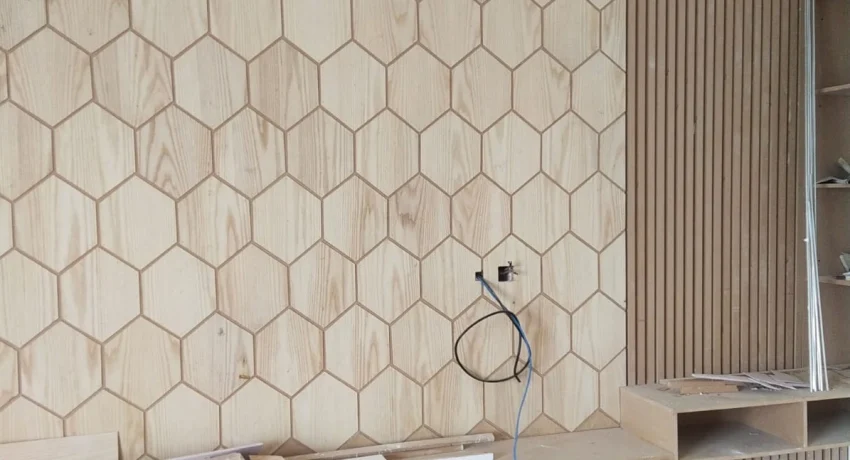STUNNING IDEAS FOR USING WOODEN PANELS ON WALL
Wall panelling has long been a beloved architectural element, blending aesthetics and functionality. In both traditional and modern homes, wooden panels on wall create a sense of character, warmth, and sophistication. Whether used to protect surfaces, add insulation, or purely for decorative purposes, wooden wall panelling transforms any interior space into a more inviting and stylish environment. This guide explores the history, types, installation methods, and various room applications of wooden panels to help you make informed and inspiring choices for your home.
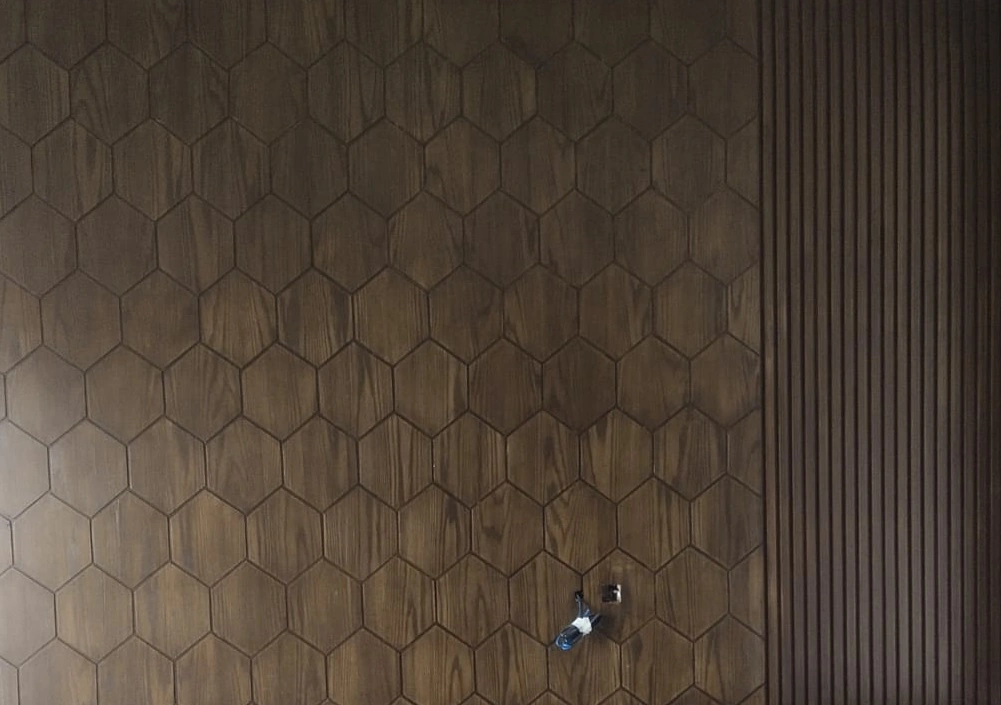
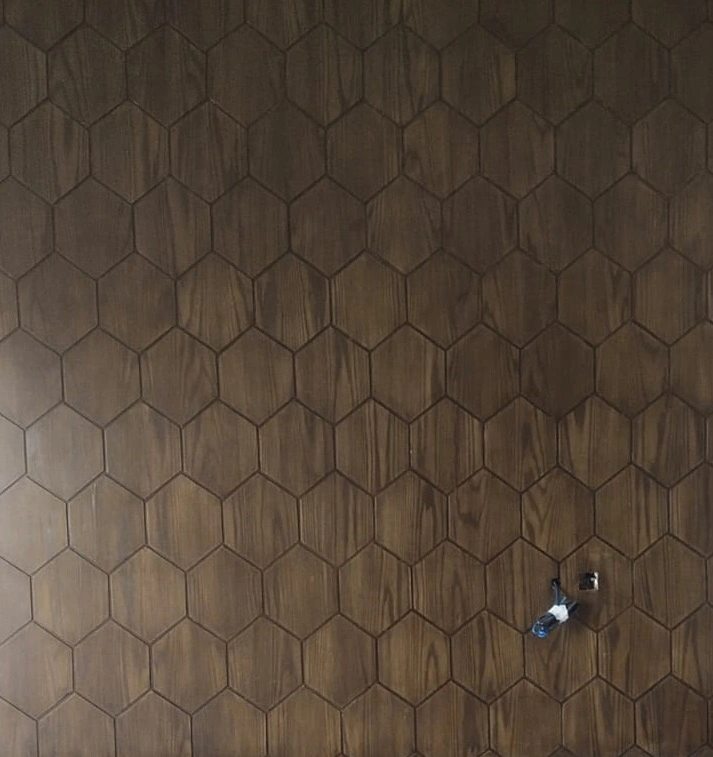
A Brief History of Wooden Panels on Wall
Wood panelling has been used in interior design since ancient times. Originally intended to insulate stone walls from damp and cold, panelling soon evolved into an important decorative element. During the Middle Ages, simple vertical boards were common, but by the 14th century, more sophisticated framed panelling appeared.
The Tudor period saw intricate carved panels, notably the famous linenfold designs. By the Georgian era, panels became simpler and larger, arranged in classical proportions, often painted to match the evolving taste for lighter, cleaner interiors. In the Victorian era, wallpaper became more popular, but wooden panelling still featured in Arts and Crafts interiors, celebrating handcrafted details. Even modernist architects incorporated wooden panelling to create warm, livable spaces.
Today, wooden panels on wall remain a versatile design tool, suited for both traditional homes and sleek contemporary spaces.
Types of Wood for Wall Panelling
Choosing the right wood is key to achieving the desired look and performance. Historically, oak and pine were the most common choices due to limited timber availability. Nowadays, a broader variety of options exists:
- Oak: A classic, durable choice with a rich grain.
- Pine: Cost-effective, good for painted panels.
- Mahogany, Teak, and Walnut: Popular during the Victorian era for luxurious interiors.
- Birch, Ash, and Douglas Fir: Common in contemporary plywood panelling.
- Nordic Spruce and Grade A Pine: Sustainable, high-quality alternatives.
For painted panelling, MDF is often used due to its stability and smooth finish. When using natural wood, it’s important to match the species to existing joinery for visual continuity. Always opt for timber certified by PEFC or FSC to ensure responsible sourcing. Reclaimed wood is another sustainable and characterful option.
Bathroom Wooden Panels on Wall
Bathrooms, often dominated by cold tiles, can greatly benefit from the warmth of wooden panels on wall. Proper material selection is critical in wet environments:
- Hardwoods like Japanese cypress, cedar, mahogany, and teak are naturally moisture resistant and highly durable.
- Douglas Fir, Siberian Larch, and Birch offer sustainable, water-resistant options.
- Birch Plywood treated with hard wax oil or polyurethane varnish provides exceptional dimensional stability.
Avoid using pine and spruce, which can warp or develop fungi. Oak is acceptable but must be sealed to prevent staining.
For budget-friendly solutions, moisture-resistant MDF, finished with waterproof paints, works well. In Georgian or Victorian style homes, installing square-edge or butt and bead wainscoting painted in modern satin finishes blends tradition with contemporary aesthetics.
However, remember that wood panelling is unsuitable for shower enclosures. Good ventilation is essential to maintain timber integrity in bathrooms.
Hall and Stair Wooden Panels on Wall
The entrance hallway sets the tone for a home, and wooden panels on wall immediately convey a sense of elegance and grandeur. Historically, Georgian townhouses used full-height panelling in halls and principal rooms, with wainscotting as a practical and decorative lower wall covering.
In Arts and Crafts homes, panel heights varied, often extending two-thirds or three-quarters up the wall and topped with a plate rail.
Modern hallways and stairs can also benefit from wood panelling:
- Plywood offers a clean, contemporary look.
- Solid wood panels bring timeless charm.
- Matching new stair panelling with existing joinery ensures visual continuity.
Installation should consider fire safety. Low-level panels rarely require special treatment, but full-height panelling may need fire retardant finishes. Pre-treated fire-resistant plywood is a safe and convenient choice.
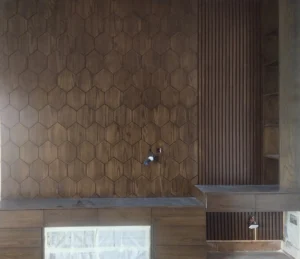
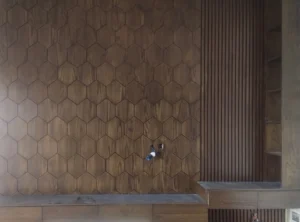
Kitchen Wooden Panels on Wall
Kitchens are functional spaces, but incorporating wooden panels on wall introduces character and warmth. When paired with modern materials like concrete, wood balances the overall atmosphere, preventing the space from feeling too industrial.
Options for kitchen wall panelling include:
- Clear varnished wood for a natural, organic look.
- Painted panels matching kitchen cabinets for a seamless design.
- Plywood panels veneered in species like oak, walnut, or birch for versatility.
Wood panelling works beautifully as a feature wall near dining areas. However, avoid placing wood close to sinks and splashbacks, where water exposure could cause warping. Tiled or stone surfaces are better suited to those areas.
Cost of Installing Wooden Panels on Wall
Several factors affect the cost of installing wooden panels:
- Type of wood: Premium hardwoods are more expensive.
- Design complexity: Intricate detailing adds to labor costs.
- Coverage area: More surface area means higher costs.
- Installation method: Concealed fixings are more labor intensive.
Estimated costs:
- Simple MDF wainscotting: Around £120 per square metre.
- Full-height MDF panels: Approximately £150 per square metre.
- Plywood panels: From £170 per square metre, depending on the fixing method.
- Traditional oak panels: Around £350 per square metre, due to specialist craftsmanship requirements.
DIY kits and budget materials can reduce costs, but for listed or period properties, expert joinery is recommended to maintain authenticity.
How to Fix Wooden Panels on Wall
The installation method depends on the type of panelling and wall condition:
- Flat walls: Panels can be glued directly using strong adhesives. Apply the glue in a zigzag pattern and press firmly. Secure with shims and props during drying.
- Uneven walls or full-height panels: Install softwood framing first to create a level substrate. Use flooring screws for a secure, discreet fixing.
For concealed fixings, a split batten system can be employed. This involves screwing battens to both the wall and the panel, allowing the panel to slot securely into place.
Narrow board styles like butt and bead can be glued and nailed directly. Attention to detail during fixing ensures longevity and a flawless finish.
Finishes for Wooden Panels on Wall
The right finish protects wood and enhances its beauty:
- Wax and resin varnishes: Traditional finishes for oak and hardwoods.
- Paint: Softwoods are often painted, typically using satinwood or semi-gloss for durability and easy cleaning.
- Hard wax oils: Offer a natural look while providing water resistance.
If restoring existing woodwork, seek specialist advice, especially for heritage properties. When applying new finishes, surfaces should be properly primed and prepared.
Maintaining wooden panels requires occasional cleaning and, for waxed surfaces, periodic reapplication of wax to nourish the timber.
Reinstating Original Wall Panelling
For older homes where the original wooden panels on wall have been lost, reinstatement brings historical depth back to the interior. Investigate surviving elements like skirting boards, architraves, and door frames for clues.
Peeling back wallpaper and inspecting paint layers may reveal scars or outlines from original panelling layouts. Visiting similar period houses in the neighborhood can provide valuable reference points.
Consultation with skilled joiners is essential when recreating traditional panelling. In listed buildings, conservation officers may require replication of original methods and materials to preserve architectural integrity.
When original panels survive, repair and make good rather than replacing them. Salvaging historical fabric is both culturally responsible and environmentally sustainable.
Modern Wooden Panels on Wall
In contemporary interiors, wooden panels on wall are far from outdated. Clean-lined, minimalist styles using plywood, vertical boards, and even veneered panels make wood highly relevant in today’s designs.
In modern homes, wooden panels:
- Provide acoustic benefits.
- Add texture and depth to minimalist schemes.
- Introduce natural warmth without sacrificing a clean aesthetic.
Scandinavian design, mid-century modern homes, and minimalist lofts all frequently feature timber wall treatments. From polished birch panels to stained oak boards, the choices are endless.
Modern panelling designs often run floor-to-ceiling and may be combined with hidden doors, storage, or built-in furniture to maximize utility without compromising design.
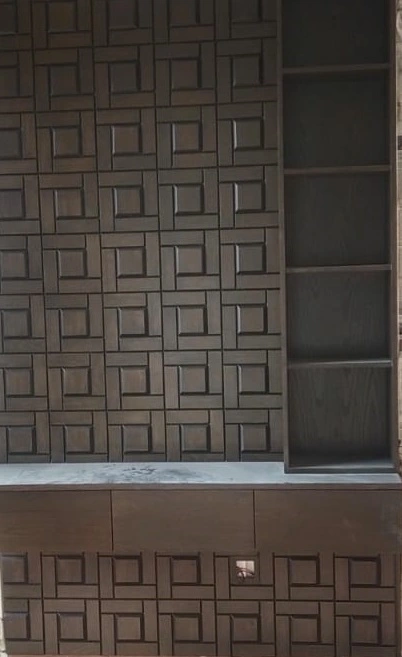
Sustainability and Environmental Considerations
Choosing eco-friendly materials is increasingly important. Opt for responsibly sourced woods certified by environmental bodies. Reclaimed timber reduces the demand for new wood and gives a second life to beautifully aged materials.
Engineered wood products like plywood also maximize yield from natural resources. When selecting finishes, prefer low-VOC (volatile organic compounds) products for healthier indoor air quality.
Sustainability doesn’t mean sacrificing style — in fact, reclaimed and responsibly sourced wood often brings added richness and depth to interior designs.

